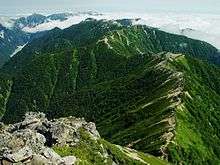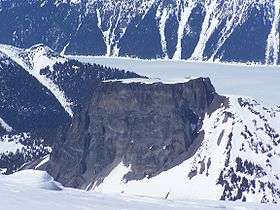Ridge
This article is about the geography and geology concept. For other uses, see Ridge (disambiguation).

A mountain ridge in Japan

A stratigraphic ridge within the Appalachian Mountains.

The edges of tuyas can form ridges.
A ridge or mountain ridge is a geological feature consisting of a chain of mountains or hills that form a continuous elevated crest for some distance. Ridges are usually termed hills or mountains as well, depending on size.
Types
There are several main types of ridges:
- Dendritic ridge: In typical dissected plateau terrain, the stream drainage valleys will leave intervening ridges. These are by far the most common ridges. These ridges usually represent slightly more erosion resistant rock, but not always – they often remain because there were more joints where the valleys formed, or other chance occurrences. This type of ridge is generally somewhat random in orientation, often changing direction frequently, often with knobs at intervals on the ridge top.
- Stratigraphic ridge: In places such as the Ridge-and-Valley Appalachians, long, even, straight ridges are formed because they are the uneroded remaining edges of the more resistant dipping strata that were folded laterally. Similar ridges have formed in places such as the Black Hills, where the ridges form concentric circles around the igneous core. Sometimes these ridges are called "hogback ridges".
- Oceanic spreading ridge: In tectonic spreading zones around the world, such as at the Mid-Atlantic Ridge, the volcanic activity forming new plate boundary forms volcanic ridges at the spreading zone. Isostatic settling and erosion gradually reduce the elevations moving away from the zone.
- Crater ridges: Large meteorite strikes typically form large impact craters bordered by circular ridges.
- Volcanic crater/caldera ridges: Large volcanoes often leave behind a central crater/caldera bordered by circular ridges.
- Fault ridges: Faults often form escarpments. Sometimes the tops of the escarpments form not plateaus, but slope back so that the edges of the escarpments form ridges.
- Dune ridges: In areas of large-scale dune activity, certain types of dunes result in sand ridges.
- Moraines and eskers: Glacial activity may leave ridges in the form of moraines and eskers. An arête is a thin ridge of rock that is formed by glacial erosion.
- Volcanic subglacial ridges: Many subglacial volcanoes create ridge-like formations when lava erupts through a thick glacier or ice sheet.
- Shutter ridges: A shutter ridge is a ridge which has moved along a fault line, blocking or diverting drainage. Typically, a shutter ridge creates a valley corresponding to the alignment of the fault that produces it.
See also
| Wikimedia Commons has media related to Ridges. |
References
This article is issued from Wikipedia - version of the 11/22/2016. The text is available under the Creative Commons Attribution/Share Alike but additional terms may apply for the media files.